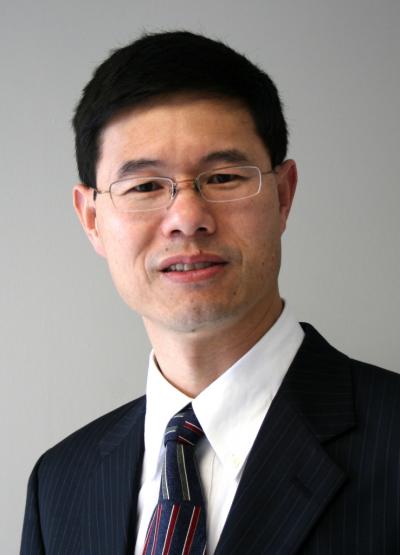Home > Press > UNC scientist proves potential of new nanoparticle design for cancer therapy
 |
| Wenbin Lin, Ph.D., of the University of North Carolina at Chapel Hill, is corresponding author of the study.
Credit: UNC Lineberger Comprehensive Cancer Center |
Abstract:
A new type of nanoparticle developed in the laboratories at the University of North Carolina has shown potential for more effective delivery of chemotherapy to treat cancer. Wenbin Lin, PhD, Kenan Distinguished Professor of Chemistry and Pharmacy, and colleagues report their finding in the Sept. 14, 2011 issue of Angewandte Chemie, the German-based flagship chemistry journal.
UNC scientist proves potential of new nanoparticle design for cancer therapy
Chapel Hill, NC | Posted on September 20th, 2011In laboratory studies, Lin and colleagues developed and tested a new type of nanoparticle that can deliver larger amounts of a drug and will not leak the drug as the particle circulates through the blood stream on its way to the target.
In the proof-of-concept experiments, they tested the nanoparticle's ability to deliver therapeutic doses of the chemotherapy drug oxaliplatin to colon and pancreatic tumors. The oxaliplatin-based particles showed significant growth inhibition of pancreatic tumors that are extremely difficult to treat. The nanoparticle has two to three times therapeutic efficacy over oxaliplatin.
The nanoparticle is different from other nanoparticles in its very high drug loading and in the ability to release in the chemotherapeutics in a controlled fashion. The release of therapeutic cargoes depends on the naturally occurring molecules that are more abundant in many tumors.
Lin explains, "The polysilsesquioxane (PSQ) particle we have developed carries extremely high loadings of oxaliplatin-based chemotherapeutics. The particles are stable under normal physiological conditions, but can be readily reduced to release the platin cargoes in highly reducing tumor microenvironments that have high concentrations of reducing agents. As a result, they have very little background release and are more easily targeted to tumors than most existing particles. We need to thoroughly determine the pharmacokinetics and other important properties of the PSQparticle in order to translate this particle platform to the clinic."
Other UNC scientists involved in the research are graduate students Joseph Della Rocca, BS; Rachel C. Huxford, MS; and Erica Comstock-Duggan, BS.
This work is supported by 2010 funding from the National Cancer Institute's Cancer Nanotechnology Platform Partnerships and the Carolina Center of Cancer Nanotechnology Excellence. These 12 partnerships and 9 centers were designed to promote and support individual, circumscribed multi-disciplinary research projects that will address major barriers and fundamental questions in cancer using innovative nanotechnology solutions.
####
For more information, please click here
Contacts:
Dianne Shaw
919-966-7834
Copyright © University of North Carolina School of Medicine
If you have a comment, please Contact us.Issuers of news releases, not 7th Wave, Inc. or Nanotechnology Now, are solely responsible for the accuracy of the content.
| Related News Press |
News and information
![]() Researchers develop molecular qubits that communicate at telecom frequencies October 3rd, 2025
Researchers develop molecular qubits that communicate at telecom frequencies October 3rd, 2025
![]() Next-generation quantum communication October 3rd, 2025
Next-generation quantum communication October 3rd, 2025
![]() "Nanoreactor" cage uses visible light for catalytic and ultra-selective cross-cycloadditions October 3rd, 2025
"Nanoreactor" cage uses visible light for catalytic and ultra-selective cross-cycloadditions October 3rd, 2025
Govt.-Legislation/Regulation/Funding/Policy
![]() New imaging approach transforms study of bacterial biofilms August 8th, 2025
New imaging approach transforms study of bacterial biofilms August 8th, 2025
![]() Electrifying results shed light on graphene foam as a potential material for lab grown cartilage June 6th, 2025
Electrifying results shed light on graphene foam as a potential material for lab grown cartilage June 6th, 2025
![]() Institute for Nanoscience hosts annual proposal planning meeting May 16th, 2025
Institute for Nanoscience hosts annual proposal planning meeting May 16th, 2025
Nanomedicine
![]() New molecular technology targets tumors and simultaneously silences two ‘undruggable’ cancer genes August 8th, 2025
New molecular technology targets tumors and simultaneously silences two ‘undruggable’ cancer genes August 8th, 2025
![]() New imaging approach transforms study of bacterial biofilms August 8th, 2025
New imaging approach transforms study of bacterial biofilms August 8th, 2025
![]() Cambridge chemists discover simple way to build bigger molecules – one carbon at a time June 6th, 2025
Cambridge chemists discover simple way to build bigger molecules – one carbon at a time June 6th, 2025
![]() Electrifying results shed light on graphene foam as a potential material for lab grown cartilage June 6th, 2025
Electrifying results shed light on graphene foam as a potential material for lab grown cartilage June 6th, 2025
Discoveries
![]() Researchers develop molecular qubits that communicate at telecom frequencies October 3rd, 2025
Researchers develop molecular qubits that communicate at telecom frequencies October 3rd, 2025
![]() Next-generation quantum communication October 3rd, 2025
Next-generation quantum communication October 3rd, 2025
![]() "Nanoreactor" cage uses visible light for catalytic and ultra-selective cross-cycloadditions October 3rd, 2025
"Nanoreactor" cage uses visible light for catalytic and ultra-selective cross-cycloadditions October 3rd, 2025
Announcements
![]() Rice membrane extracts lithium from brines with greater speed, less waste October 3rd, 2025
Rice membrane extracts lithium from brines with greater speed, less waste October 3rd, 2025
![]() Researchers develop molecular qubits that communicate at telecom frequencies October 3rd, 2025
Researchers develop molecular qubits that communicate at telecom frequencies October 3rd, 2025
![]() Next-generation quantum communication October 3rd, 2025
Next-generation quantum communication October 3rd, 2025
![]() "Nanoreactor" cage uses visible light for catalytic and ultra-selective cross-cycloadditions October 3rd, 2025
"Nanoreactor" cage uses visible light for catalytic and ultra-selective cross-cycloadditions October 3rd, 2025
|
|
||
|
|
||
| The latest news from around the world, FREE | ||
|
|
||
|
|
||
| Premium Products | ||
|
|
||
|
Only the news you want to read!
Learn More |
||
|
|
||
|
Full-service, expert consulting
Learn More |
||
|
|
||








